
Vision Engineering’s DRV (Deep Reality Viewer) digital 3D stereoscopic display technology creates stereo high-definition 3D images without using a monitor or requiring operators to wear headsets or specialist glasses because images "float" in front of a mirror.
DRV offers users the well-known Vision Engineering advantages of ergonomics and optimized user interfaces, while ensuring full interaction with other local or remote users and other tools/PC’s or complementary analytical equipment.
Vision Engineering anticipates that this unique device will be particularly valuable to organizations that model and test components in 3D, as well as facilitating improvements in manufacturing processes such as PCB inspection and reworking. DRV has the particular advantage for multi-site companies of offering real time, full HD 3D stereo images to multiple users in different locations at the same time (commonly known as “daisy chaining”).
Manufacturing companies have tried to exploit the potential offered to them by consumer driven technological trends in virtual reality, augmented reality and 3D polarized/shutter glass viewing. Along with the advantages of these technologies, they have experienced substantial drawbacks in sensory isolation, disorientation and resolution.
Modern manufacturing techniques involve multi-site communicability in real time. The latest trends of AI the IoT and the cascade effect of Blockchain require information to be accessible to multiple users, at the same time, with the same fidelity.
Developed to address quality control and production requirements in sectors including electronics, aerospace, automotive and medical industries, DRV offers full, real time transferability of information to multi-site manufacturers, designers or users of multiple-tier development and logistic capabilities.
Using Vision Engineering’s TriTeQ3 digital 3D display technology, the DRV-Z1 (Zoom model 1) incorporates a zoom microscope module and is the first device of its class to be launched by the manufacturer.
DRV-Z1 is designed to advance the quality control and production process, by enabling operators to view magnified subjects in 3D, in unprecedented detail, without the need for additional viewing apparatus.
Commenting on the technological breakthrough, Mark Curtis, managing director of Vision Engineering said, “Over the past 60 years Vision Engineering has built its reputation on the innovation, quality, performance and ergonomics of our visual inspection and metrology systems. DRV-Z1 provides enhanced 3D visualization and overcomes current problems with 3D modelling and inspection systems. By amalgamating our existing technologies, we’ve delivered an entirely new concept to our existing customer base, as well as opening up opportunities in fresh markets.”
Highlights:
- Unique deep reality viewer enables stereoscopic 3D viewing with vivid depth perception, at UHD resolution, without requiring special eyewear or VR headsets
- Developed to address QC and QA requirements in electronics, automotive engineering, aerospace industries and all precision engineering applications
- Break-through technology from the inventors of the award-winning ergonomic Mantis microscopes: the original and best
- First of its class
- An amalgamation of Vision Engineering’s award-winning optical stereoscopic and digital technologies resulting in stereo digital images
- Ergonomic design reduces operator fatigue and promotes productivity and accuracy
- Enables remote viewing of dynamic 3D images in in stereo full HD
- Enables improved accuracy in manufacturing processes such as deburring and reworking
- DRV-Z1 is the first in series of innovative 3D stereo full HD resolution viewing systems, based on Vision Engineering’s patented TriTeQ3 technology
Contact Details
Related Glossary Terms
- fatigue
fatigue
Phenomenon leading to fracture under repeated or fluctuating stresses having a maximum value less than the tensile strength of the material. Fatigue fractures are progressive, beginning as minute cracks that grow under the action of the fluctuating stress.
- metrology
metrology
Science of measurement; the principles on which precision machining, quality control and inspection are based. See precision machining, measurement.
- quality assurance ( quality control)
quality assurance ( quality control)
Terms denoting a formal program for monitoring product quality. The denotations are the same, but QC typically connotes a more traditional postmachining inspection system, while QA implies a more comprehensive approach, with emphasis on “total quality,” broad quality principles, statistical process control and other statistical methods.







